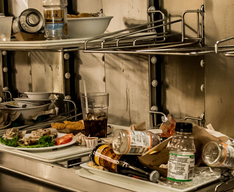If it’s a priority for the consumer, it certainly needs to be a priority for the restaurant as well.
In the restaurant industry, we see more food than anybody in America. It may come as a surprise that despite this abundance of food there are still millions of people who have no idea where their next meal is coming from. According to Feeding America, America produces an estimated 70 billion tons of food waste each year. Nearly half of the food grown, processed, and transported in the U.S. ends up going to waste. Think about the impact on food costs if every bit of food was used in some capacity to feed people or animals.
A study by Unilever, revealed that 72 percent of U.S. diners said that they care about how food waste is handled. Another 47 percent are concerned enough that they stated they would be willing to spend more money to eat at a place that actively tries to reduce its food waste production. If it’s a priority for the consumer, it certainly needs to be a priority for the restaurant as well.

How do you take steps to reduce the food waste in your restaurant? What can your back of house team do? How much money are you wasting that you could potentially put back to your bottom line? These are all great questions to be asked and can help you begin working on your overall waste reduction program. Here are five tips to get your overall waste reduction program started.
Know your inventory. You won’t use what you don’t know you have. Always know what you’re purchasing and what you have on hand. Understanding your restaurants sales trends around certain items will also be key. This knowledge will help to not overbuy, which will not only reduce the amount of food waste but also produce cost savings to the bottom line.
Understand your waste stream. Review and understand what your kitchen is throwing out and why. Perhaps you’re making too many salads too early in the day and they’re ending up in your dumpster. It could be that the kitchen staff is not reading the orders correctly resulting in meals being sent back to the kitchen and dumped. Either way, understanding what’s ending up in the dumpster can help you better understand how to prevent it.
Educate your staff. Making sure that your staff knows how to properly store and prepare product, allows for it to have more longevity and ensures you’ll get the most use. It’s also important to train your staff on how to properly handle that product once it’s reached its unsaleable point. Options for donation, composting or recycling should be explored prior to landfill.
Find alternatives to Landfill. Follow the food waste hierarchy pyramid and try to donate unused food to an organization for people in need. If unable to be donated, explore options for feeding animals, anaerobic digestion or even composting prior to committing it to landfill.
Measure and review often. It’s important to understand where you were, where you are and where you want to be. Establish a benchmark and then begin tracking your waste reduction efforts against that benchmark to ensure that you’re meeting your goals and obtaining the success you require.
Putting these five tips into practice will set your restaurant up for success in better managing your overall waste stream. With that under control you can start to market your efforts to your customers and enjoy the benefits of a positive brand image and potential cost savings to your bottom line.
Content source QSR Magazine
